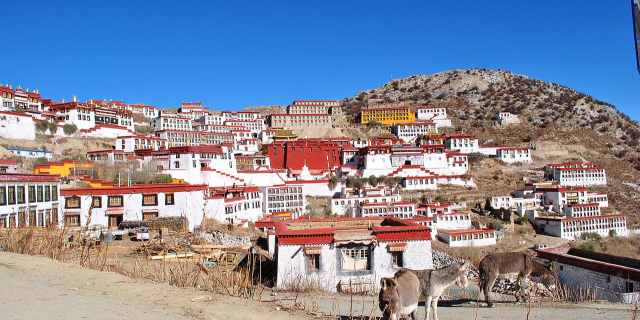雍布拉康
( Yungbulakang Palace )Yumbu Lakhang (Tibetan: ཡུམ་བུ་བླ་སྒང།, Wylie: yum bu bla sgang; Chinese: 雍布拉康) or Yumbu Lakhar (Tibetan: ཡུམ་བུ་བླ་མཁར།, Wylie: yum bu bla mkhar, also known as Yumbu Lakhang) is an ancient structure in the Yarlung Valley in the vicinity of Tsetang, Nêdong County, the seat of Lhoka Prefecture, in Tibet.
According to legend, it was the first building in Tibet and the palace of the first Tibetan king, Nyatri Tsenpo. Yumbu Lakhang stands on a hill on the eastern bank of the Yarlung River in the Yarlung Valley of southeast Nêdong County about 192 kilometres (119 mi) southeast of Lhasa and 9 kilometres (5.6 mi) south of Tsetang.
According to Tibetan traditions, Yumbu Lakhang was built for the first Tibetan king, Nyatri Tsenpo, who descended from the sky with his grandmother. It was probably built at the turn of the seventh and eighth centuries.[1] During the reign of the 28th king, Thothori Nyantsen, in the fifth century AD, a golden stupa, a jewel (and/or a form to the manufacture of dough-Stupas)[2] and a sutra that no one could read fell from the sky onto the roof of the Yumbu Lakhang; a voice from the sky announced, "In five generations one shall come that understands its meaning!"[3] Later, Yumbu Lakhang became the summer palace of the 33rd Tibetan king, Songtsen Gampo (604-650 AD) and his Chinese princess, Wencheng. After Songtsen Gampo had transferred the seat of his temporal and spiritual authority to Lhasa, Yumbu Lakhang became a shrine.
A thousand years later, during the reign of the 5th Dalai Lama (1617-82), the palace was turned into a monastery for the Gelug school.
The Yumbu Lakhang was heavily damaged and reduced to a single storey during the Cultural revolution[4] but was reconstructed in 1983.[5][6]
As of November 2017 the palace is undergoing $1.5m of restoration works to reinforce its crumbling wooden foundations and cracked walls. It was expected to reopen to the public in April 2018.[7]





































Add new comment